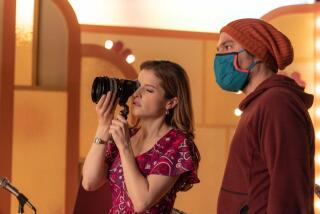‘The Water Is Wide,’ but not very deep
“The Water Is Wide,” which airs Sunday night on CBS as “the 226th Presentation of the Hallmark Hall of Fame,” is a heavily filtered adaptation of Pat Conroy’s “autobiographical novel” -- more a thinly veiled memoir than a proper novel -- about his year teaching elementary school on Daufuskie Island, S.C., here called Yamacraw Island, at the close of the 1960s. (Conroy’s name stays the same, but other details change.) It’s a thing of obvious -- too obvious -- good intentions, and doubtless there are some who will feel the intended uplift, just as are those for whom a Hallmark Card is the quintessence of poetry.
Any chance to watch Alfre Woodard work is a chance worth taking, but this one pays few other dividends. Woodard plays Mrs. Brown, Conroy’s fellow teacher and principal at the island’s two-room schoolhouse. She has a high regard for corporal punishment, tells her class to “mind your manners -- don’t act your color,” and tells Conroy (Jeff Hephner) that the only way to teach black children is to “step on them” and keep on stepping. Her authority for this is that she is herself “colored.”
Conroy, by contrast, is a slightly long-haired white kid who believes in questioning authority and sparing the rod to save the child. It is yet another talking-picture tale of the idealistic teacher reaching out to kids who’ve been written off, and it is also yet another tale of the unconventional teacher who breaks through to them by breaking the rules. (See also: “Dangerous Minds,” “To Sir With Love,” “Dead Poets Society,” and also “Mona Lisa Smile,” “Stand and Deliver.”) Indeed, it is yet another adaptation of “The Water Is Wide,” already made in 1974 as “Conrack,” starring Jon Voight and directed by Martin Ritt, who also made “Sounder.”
The director here is John Kent Harrison, who several years ago directed another Southern tale for the Hallmark Hall of Fame, the excellent “Old Man,” from a William Faulkner novella about a flood on the Mississippi, which captured the sense of place, of life and weather in a way “The Water Is Wide” does not. On a technical level, the film is polished and pretty -- too much so, really. You can’t feel the air, but you can almost sense the dressing room trailers and the craft services tables just behind the camera. None of this is helped by the sweeping and sentimental score, slathered on like pink frosting.
This is a collection of feel-good moments (of a sometimes surpassing phoniness) in search of a plot. This isn’t completely surprising, because the book, really just a journal of Conroy’s experience teaching, fighting mainland bureaucrats (Frank Langella plays the superintendent of schools) and getting married, doesn’t really have a plot. But what it does have is a detail and attitude, both of which are missing here, as well as the amused but critical eye that the author turns on himself.
This Conroy barely registers as anything more than a nice guy with a bit of a stubborn streak, occasionally haunted by the ghost of his martinet military father (immortalized elsewhere as “The Great Santini”). Though he later wonders, in flashback narration, whether the kids changed him more than he changed them, in the film he doesn’t change at all. There is Conroy with his ideas, and Mrs. Brown and the Board of Education with theirs, and someone will have to go. The minor characters -- who are lively and complex on the page -- have become simple signifiers of either goodwill or ill will, with all their personality squeezed into friendly smiles or sullen scowls.
In the same way, the political and racial context of the book -- which is significant, and includes Conroy’s confession of his own past casual racism -- has been downplayed, as if Hallmark, being Hallmark, wishes to give no one offense. (It had only been four years since the Voting Rights Act when Conroy went to the island, and the wings of Jim Crow were still spread wide; it was a time when even people of goodwill mouthed stereotypes.)
Mrs. Brown is also softened, and given a reason for being so deferential to her bosses and hard on her charges -- it’s that she’s “a professional black woman trying to make it in a white male South” -- when her model is a more complex picture of ego, religious zeal and self-hatred. And she is allowed her moments of redemption and humanity: As her class sits with hands folded and knees together at a graduation ceremony, Conroy’s students clamber over him as if he were a jungle gym, her reflexive disapproval now overcome by regret. Finally, she will speak up in a small way for Conroy, when his bosses have had enough of him. Woodard is good as always, but it’s stock stuff, and there’s only so much she can do with it.
The child actors do an excellent job of seeming to have been born in a world before hip-hop.
More to Read
Only good movies
Get the Indie Focus newsletter, Mark Olsen's weekly guide to the world of cinema.
You may occasionally receive promotional content from the Los Angeles Times.











